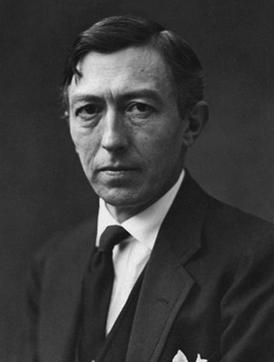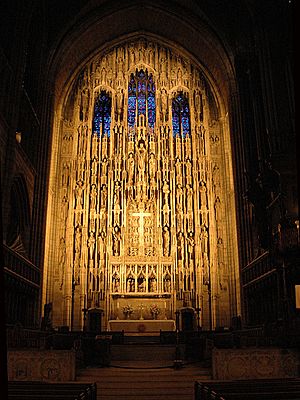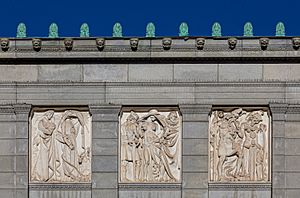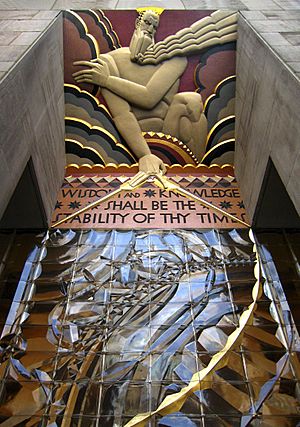Lee Lawrie facts for kids
Quick facts for kids
Lee Oscar Lawrie
|
|
|---|---|
 |
|
| Born | October 16, 1877 Rixdorf, Germany
|
| Died | January 23, 1963 (aged 85) Easton, Maryland, United States
|
| Nationality | German-American |
| Alma mater | Yale University |
| Known for | Sculptor |
|
Notable work
|
Atlas in collaboration with Rene Paul Chambellan |
| Style | Gothic, Beaux-Arts, Classicism, Art Deco |
Lee Oscar Lawrie (born October 16, 1877 – died January 23, 1963) was a very important American sculptor. He created amazing sculptures for buildings. He is known as one of the top architectural sculptors in the United States before World War II.
During his long career, he made over 300 sculptures! His style changed over time, from Gothic to Art Deco.
He created a large sculpture called a frieze on the Nebraska State Capitol building. This frieze shows important moments, like the announcement of the Emancipation Proclamation. He also made his most famous work, the huge bronze statue of Atlas. This statue was put up in 1937 at New York City's Rockefeller Center.
Lawrie's art can be seen on many famous buildings across the United States. His style changed as building styles changed. He worked on buildings that were Beaux-Arts, neo-Gothic, and Art Deco. Many of his sculptures were for buildings designed by Bertram Goodhue. These include the chapel at West Point, the National Academy of Sciences in Washington, D.C., and the Los Angeles Public Library. He also made sculptures for the Library of Congress and the Washington National Cathedral.
Contents
Early Life and Training
Lee Lawrie was born in Rixdorf, Germany, in 1877. When he was a young child in 1882, his family moved to the United States. They settled in Chicago. There, at just 14 years old, he started working for a sculptor named Richard Henry Park.
In 1892, when he was 15, Lawrie helped many sculptors in Chicago. They were building the "White City" for the World's Columbian Exposition of 1893. After this big project, Lawrie moved East. He became an assistant to William Ordway Partridge. Over the next ten years, he worked with other famous sculptors. These included Augustus Saint-Gaudens and Alexander Phimister Proctor.
His work at the Louisiana Purchase Exposition in St. Louis in 1904 was very important. He worked under Karl Bitter, who was a leading architectural sculptor. This helped Lawrie improve his skills and become well-known.
Lawrie earned a degree in fine arts from Yale University in 1910. He taught at Yale's School of Fine Arts from 1908 to 1919. He also taught architecture at Harvard University from 1910 to 1912.
Working with Famous Architects
Lawrie worked closely with architects Ralph Adams Cram and Bertram Goodhue. These partnerships helped him become one of the top architectural sculptors in the U.S. After Cram and Goodhue's company split up in 1914, Lawrie kept working with Goodhue. He continued to work with Goodhue's team even after Goodhue passed away in 1924.
Lawrie created many sculptures for El Fureidis, a large estate in Montecito, California. Goodhue designed this estate. The sculptures show scenes from the Arthurian Legends. They are still there today.
His work on the Nebraska State Capitol and the Los Angeles Public Library is very special. The sculptures are a big part of the buildings' design and meaning. Many people believe his work with Goodhue is the best example of architectural sculpture in American history.
Lawrie was a consultant for the 1933-34 Century of Progress International Exposition in Chicago. He was also a member of important art groups. These included the American Academy of Arts and Letters. He won many awards, including medals from the American Institute of Architects. He also received an honorary degree from Yale University. He served on the U.S. Commission of Fine Arts in Washington, D.C., which looks after public art.
Key Projects with Goodhue
Here are some of the important buildings Lawrie worked on with Bertram Goodhue:
- Marble reliefs above the windows of the Deborah Cook Sayles Public Library in Pawtucket, Rhode Island (1902).
- Chapel at West Point, New York.
- Church of St. Vincent Ferrer in New York City.
- Pulpit and Lectern carvings at St. Bartholomew's Episcopal Church.
- Reredos (a screen behind an altar) at Saint Thomas Church on Fifth Avenue in New York City.
- Nebraska State Capitol in Lincoln, Nebraska.
- Los Angeles Public Library in Los Angeles, California.
- National Academy of Sciences Building in Washington, D.C..
- Rockefeller Chapel at the University of Chicago.
- Christ Church Cranbrook in Bloomfield Hills, Michigan.
Later Works
Rockefeller Center
After Goodhue passed away, Lawrie created very famous works at Rockefeller Center in New York City. He worked with Raymond Hood and Rene Paul Chambellan.
Lawrie's most famous work is the Atlas statue. It stands freely on Fifth Avenue at Rockefeller Center. The entire statue is 45 feet tall! The human figure holding the armillary sphere is 15 feet tall. This statue is a great example of Art Deco style.
Another important piece is Wisdom, located above the entrance to 30 Rockefeller Plaza. It is one of the most visible artworks in the complex. This Art Deco piece shows power, just like Atlas and Paul Manship's Prometheus.
Other Important Projects
- Sculptures called Courage, Patriotism and Wisdom above the doors to the United States Senate chamber in Washington, D.C..
- Education Building in Harrisburg, Pennsylvania.
- Louisiana State Capitol in Baton Rouge, Louisiana.
- Peace Memorial at Gettysburg, Pennsylvania.
- Sculptures for the Fidelity Mutual Life Building in Philadelphia, Pennsylvania. These include an owl for wisdom and a dog for loyalty.
- Statue of George Washington at the Washington National Cathedral.
- Friezes for the Ramsey County Courthouse in Saint Paul, Minnesota.
- Two Egyptian-style sculptures for the 1924 Hale Solar Laboratory in Pasadena, California.
- Bronze doors of the John Adams Building at the Library of Congress Annex.
- Harkness Memorial Tower and Sterling Memorial Library at Yale University.
- Beaumont Tower at Michigan State University.
- Bok Singing Tower in Mountain Lake, Florida.
- Designed sculptures for the Brittany American Cemetery and Memorial in Brittany, France.
- Soldiers and Sailors Memorial Bridge in Harrisburg, Pennsylvania (1930).
Images for kids
-
Soldiers and Sailors Memorial Bridge, Harrisburg, Pennsylvania, (1930)
-
Sculpted bronze figures of Hermes and Itzamna (1939)
-
Sculpted bronze figures of Nabu and Tahmurath (1939)
-
Sculpted bronze figures of Odin and Quetzalcoatl (1939)
-
Sculpted bronze figures of Ogma and Sequoyah (1939)
See also
 In Spanish: Lee Lawrie para niños
In Spanish: Lee Lawrie para niños














